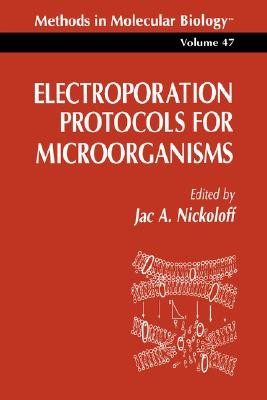
- We will send in 10–14 business days.
- Publisher: Humana
- ISBN-10: 0896033104
- ISBN-13: 9780896033108
- Format: 15.2 x 22.9 x 2.2 cm, softcover
- Language: English
- SAVE -10% with code: EXTRA
Electroporation Protocols for Microorganisms (e-book) (used book) | bookbook.eu
Reviews
Description
Electroporation is one of the most widespread techniques used in modem molecular genetics. It is most commonly used to introduce DNA into cells for investigations of gene structure and function, and in this regard, electroporation is both highly versatile, being effective with nearly all species and cell types, and highly efficient. For many cell types, electroporation is either the most efficient or the only means known to effect gene transfer. However, exposure of cells to brief, hi- intensity electric fields has found broad application in other aspects of biological research, and is now routinely used to introduce other types of biological and analytic molecules into cells, to induce cell-cell fusion, and to transfer DNA directly between different species. The first seven chapters of Electroporation Protocols for Micro- organisms describe the underlying theory of electroporation, the com- mercially available instrumentation, and a number of specialized electroporation applications, such as cDNA library construction and interspecies DNA electrotransfer. Each of the remaining chapters pre- sents a well developed method for electrotransformation of a particular bacterial, fungal, or protist species. These chapters also serve to intro- duce those new to the field the important research questions that are currently being addressed with particular organisms, highlighting both the major advantages and limitations of each species as a model organ- ism, and explaining the roles that electroporation has played in the development of the molecular genetic systems currently in use.
EXTRA 10 % discount with code: EXTRA
The promotion ends in 20d.19:54:26
The discount code is valid when purchasing from 10 €. Discounts do not stack.
- Publisher: Humana
- ISBN-10: 0896033104
- ISBN-13: 9780896033108
- Format: 15.2 x 22.9 x 2.2 cm, softcover
- Language: English English
Electroporation is one of the most widespread techniques used in modem molecular genetics. It is most commonly used to introduce DNA into cells for investigations of gene structure and function, and in this regard, electroporation is both highly versatile, being effective with nearly all species and cell types, and highly efficient. For many cell types, electroporation is either the most efficient or the only means known to effect gene transfer. However, exposure of cells to brief, hi- intensity electric fields has found broad application in other aspects of biological research, and is now routinely used to introduce other types of biological and analytic molecules into cells, to induce cell-cell fusion, and to transfer DNA directly between different species. The first seven chapters of Electroporation Protocols for Micro- organisms describe the underlying theory of electroporation, the com- mercially available instrumentation, and a number of specialized electroporation applications, such as cDNA library construction and interspecies DNA electrotransfer. Each of the remaining chapters pre- sents a well developed method for electrotransformation of a particular bacterial, fungal, or protist species. These chapters also serve to intro- duce those new to the field the important research questions that are currently being addressed with particular organisms, highlighting both the major advantages and limitations of each species as a model organ- ism, and explaining the roles that electroporation has played in the development of the molecular genetic systems currently in use.


Reviews